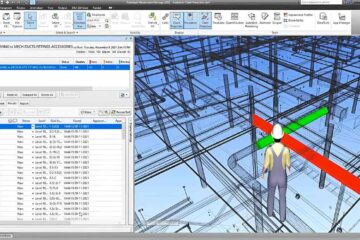Professional BIM Coordination Services in Boston
What are BIM Coordination Services and Why are They Important?
Understanding the Basics of BIM
Building Information Modeling (BIM) is a process that involves creating and managing digital representations of physical and functional characteristics of buildings. BIM allows for the coordination and collaboration of various stakeholders involved in the design, construction, and operation of a building.
Key concepts of BIM include:
1. 3D modeling: BIM uses 3D models to represent the physical characteristics of a building, including its geometry, materials, and spatial relationships.
2. Information sharing: BIM facilitates the sharing of information among different stakeholders, allowing for improved communication and collaboration.
3. Parametric modeling: BIM models are often parametric, meaning that changes made to one aspect of the model will automatically update other related aspects.
4. Clash detection: BIM software can detect clashes or conflicts between different building elements, helping to identify and resolve issues before construction begins.
5. Life cycle management: BIM can be used throughout the entire life cycle of a building, from design and construction to maintenance and renovation.
6. Data integration: BIM allows for the integration of various data sources, such as cost estimates, schedules, and environmental impact assessments, to support decision-making processes.
Overall, BIM helps improve the efficiency, accuracy, and sustainability of building projects by providing a comprehensive digital representation of the building and its components.
Benefits of Utilizing BIM Coordination Services
1. Improved Collaboration: BIM coordination services facilitate better collaboration among different stakeholders involved in a construction project. By using a common digital platform, architects, engineers, contractors, and other team members can easily share and access project data, leading to more efficient communication and problem-solving.
2. Clash Detection: One of the key benefits of BIM coordination services is clash detection. By creating a 3D model of the project, potential clashes and conflicts between different building elements can be identified early on in the design process, reducing the risk of construction delays and rework.
3. Cost Savings: BIM coordination services can help identify potential design errors and clashes before construction begins, saving time and money that would otherwise be spent on rework, with BIM services in Boston playing a pivotal role. Additionally, by optimizing the building design and construction process, project costs can be reduced.
4. Improved Decision Making: Using BIM coordination services gives project stakeholders access to real-time data and visualizations, allowing them to make informed decisions quickly and confidently. Additionally, incorporating architectural BIM and MEPF elements can significantly enhance the model’s accuracy and utility. This can help streamline the decision-making process and avoid costly mistakes.
5. Enhanced Project Visualization: BIM coordination services enable project stakeholders to create detailed 3D models of the building design, providing a better understanding of the project’s scope and requirements. This can help improve the overall quality of the design and ensure that the project meets client expectations.
6. Sustainability: BIM coordination services can help optimize building performance and sustainability by simulating different design scenarios and identifying opportunities for energy efficiency and cost savings. This can help reduce the environmental impact of the project and meet sustainability goals.
7. Streamlined Construction Process: By utilizing BIM coordination services, construction teams can better plan and coordinate the building process, leading to improved productivity, shorter construction times, and reduced project delays. This can help ensure that the project is completed on time and within budget.
Implementing BIM in Construction Projects
Building Information Modeling (BIM) is a powerful tool that is transforming the construction industry by enabling greater collaboration, efficiency, and accuracy throughout the project lifecycle. Implementing BIM in construction projects involves several key steps to ensure its successful integration and adoption by all project stakeholders.
1. Define project goals and requirements: Before implementing BIM, it is important to clearly define the goals and requirements of the project, including specific LOD (Level of Detail) targets and any necessary Revit family creation for custom components. This includes determining the level of detail required for the BIM model, the scope of work to be covered, and the expected outcomes of using BIM.
2. Educate project team on BIM: BIM is a relatively new technology in the construction industry, so it is important to educate the project team on the benefits and capabilities of BIM. This may involve training sessions, workshops, and hands-on practice with BIM software.
3. Select the right BIM software: There are several BIM software options available in the market, so it is important to select the one that best meets the project requirements. Consider factors such as ease of use, compatibility with other software tools, and the level of support provided by the software vendor.
4. Establish BIM standards and protocols: To ensure consistency and efficiency in the use of BIM across the project team, it is important to establish BIM standards and protocols. This may include defining naming conventions, file formats, information exchange protocols, and collaboration procedures relevant to BIM services in Boston.
5. Develop a BIM execution plan: A BIM execution plan outlines the workflow, responsibilities, and timeline for implementing BIM in the project. It should include a detailed schedule of BIM activities, roles and responsibilities of team members, and communication and collaboration procedures, underpinned by BIM services in Boston.
6. Create the BIM model: Once the BIM software is selected and the standards and protocols are established, the project team can begin creating the BIM model, often with the support of scan to BIM services Boston. This involves developing 3D models of the building or infrastructure project, adding relevant data and information, and incorporating feedback from stakeholders.
7. Collaborate and coordinate with project stakeholders: One of the key benefits of BIM is its ability to facilitate collaboration and coordination among project stakeholders. Use BIM to streamline communication, share information in real-time, and resolve conflicts or issues that may arise during the construction process.
8. Monitor and assess BIM implementation: Throughout the project lifecycle, it is important to monitor and assess the implementation of BIM to ensure that project goals are being met. Use key performance indicators (KPIs) to track progress, identify areas for improvement, and make adjustments as needed.
By following these steps, construction projects can successfully implement BIM and leverage its benefits to improve project outcomes, reduce costs, and deliver high-quality buildings and infrastructure.
Enhanced Clash Detection and Resolution
Clash detection and resolution are critical processes in construction and engineering projects to identify and eliminate conflicts and interferences between different building components before construction begins. While traditional clash detection methods involve manually checking for clashes using 2D drawings or 3D models, enhanced clash detection technologies and software tools are now available to streamline the process and improve accuracy.
One advanced technology that has revolutionized clash detection is Building Information Modeling (BIM). BIM software allows for the creation of highly detailed 3D models that integrate all building components and systems, including structural, architectural, mechanical, electrical, and plumbing elements. These comprehensive models enable clash detection to be performed more effectively by automatically identifying clashes between different elements based on predefined rules and criteria.
In addition to BIM software, other advanced clash detection tools incorporate artificial intelligence and machine learning algorithms to enhance the accuracy and efficiency of clash detection and resolution processes. These tools can analyze large volumes of data and identify potential clashes that may have been overlooked using traditional methods, enabling project teams to address conflicts proactively and prevent costly rework during construction.
Moreover, virtual reality (VR) and augmented reality (AR) technologies are being increasingly used in clash detection to visualize clashes in a more immersive and interactive manner. Project teams can use VR and AR simulations to navigate through the 3D models, identify clashes in real-time, and collaborate on resolving conflicts more efficiently with the aid of BIM coordination services Boston.
Overall, enhanced clash detection and resolution technologies offer significant benefits to construction and engineering projects, including improved collaboration, reduced errors and rework, faster project delivery, and cost savings. By leveraging these advanced tools and methodologies, project teams can mitigate risks and ensure the successful completion of complex building projects.
Cost Estimation and Project Visualization with BIM
Building Information Modeling (BIM) is a powerful tool that not only helps in visualizing the project but also in estimating the costs accurately. BIM allows for a 3D model of the building to be created, including all the details of materials, quantities, and labor required for the construction, facilitated by advanced BIM modeling services. This process is enriched with LOD specifications and Revit family creation capabilities to ensure precision and customizability.
One of the key benefits of using BIM for cost estimation is the ability to create accurate quantity takeoffs. By having a detailed 3D model of the project, all the materials needed can be easily identified and measured, leading to a more precise estimate of costs.
Furthermore, BIM allows for the integration of cost data directly into the model, enabling cost estimators to easily update and track changes in real-time. This capability is further enhanced by detailed design services that include MEPF coordination and Revit family creation. This not only saves time but also ensures that the estimates are always up-to-date and accurate.
In addition to cost estimation, BIM also enhances project visualization by providing a realistic 3D model of the building. This allows stakeholders to better understand the project and make informed decisions throughout the construction process.
Overall, BIM is a valuable tool that can help streamline the cost estimation process and enhance project visualization, leading to more successful construction projects.
Efficient MEP Coordination in BIM Models MEP
Coordination is a critical part of any building construction project, as it involves the coordination and integration of mechanical, electrical, and plumbing systems within a building. One of the most effective ways to accomplish this coordination is through the use of Building Information Modeling (BIM) technology.
BIM allows all stakeholders – architects, engineers, contractors, and owners – to collaborate and share information in a centralized digital model of the building. This model includes not only architectural elements but also MEP systems, allowing for real-time coordination and clash detection.
To ensure efficient MEP coordination in BIM models, the following best practices should be followed:
1. Early involvement of MEP engineers: MEP engineers should be involved in the design process from the beginning to ensure that the MEP systems are integrated seamlessly into the architectural design.
2. Use of clash detection tools: BIM software offers clash detection tools that can identify conflicts between MEP systems and other building elements. These clashes can be resolved before construction begins, saving time and money.
3. Regular coordination meetings: Regular coordination meetings should be held between all stakeholders to review the model, identify potential clashes, and work together to find solutions.
4. Clear communication: Effective communication is key to successful MEP coordination. All team members should be able to access and update the BIM model, and any changes or updates should be communicated to all stakeholders in a timely manner. Leveraging LOD and 4D planning ensures that each detail is accurately represented and timelines are closely monitored.
5. Continuous updating of the model: The BIM model should be continuously updated throughout the construction process to reflect any changes or modifications to the MEP systems. This ensures that the most up-to-date information is always available to all team members.
By following these best practices, MEP coordination in BIM models can be achieved efficiently and effectively, leading to a smoother construction process and a higher-quality building in the end.
What are BIM Coordination Services and Why are They Important?
Building Information Modeling (BIM) coordination services involve creating a digital representation of the physical and functional characteristics of a construction project, integrating LOD standards and 4D planning to enhance visualization and project management. BIM models integrate architectural, MEP, and structural elements into a single detailed model, leveraging LOD specifications to enhance collaboration and efficiency throughout the project lifecycle. This technology allows stakeholders to visualize the project in a 3D environment, enabling better decision-making and coordination.
Utilizing BIM coordination services offers numerous benefits, including improved clash detection, accurate cost estimation, and enhanced project visualization. By streamlining the design and construction process, BIM helps identify and resolve clashes before they occur on-site, saving time and reducing costly rework.
Implementing BIM in construction projects requires expertise in various software, such as Revit and CAD, to develop detailed models that reflect the project’s scope. This often involves consulting with BIM consulting services to enhance project outcomes. This digital representation facilitates seamless coordination among stakeholders and ensures the project’s successful completion.
How to Choose the Best BIM Coordination Services in Boston?
When selecting BIM service providers in Boston, several key factors should be considered to ensure the success of your construction project, including expertise in scan to BIM and modeling services. Look for providers with a proven track record of delivering high-quality BIM coordination services and expertise in architectural and MEP coordination.
Comparing BIM coordination services in Boston involves evaluating factors such as experience, technology proficiency, and project portfolio. Client testimonials and case studies can provide valuable insights into the provider’s capabilities and service quality.
Client testimonials and case studies play a crucial role in evaluating the effectiveness of BIM coordination services. Real-world examples highlight the provider’s ability to deliver results and add value to construction projects in Boston, showcasing skills in architectural BIM, MEPF integration, and the use of advanced 4D scheduling techniques.
What Is the BIM Coordination Process and How Does It Work?
The BIM coordination process involves creating a collaborative environment where all stakeholders work together to develop a coordinated BIM model. This model includes architectural, MEP, and structural elements, allowing for clash detection and resolution before construction begins.
Various stakeholders, including architects, engineers, and contractors, play key roles in BIM coordination by contributing their expertise to the development of the digital model. Their collaboration ensures that the final model accurately reflects the design intent and construction requirements.
Seamless integration of BIM with the construction workflow enhances communication and coordination among project teams. By aligning BIM processes with construction activities, stakeholders can optimize project timelines, reduce errors, and improve overall project efficiency.
Benefits of Expert BIM Coordination Services for Construction Projects
Expert BIM coordination services offer enhanced clash detection and resolution capabilities, enabling project teams to identify and address conflicts early in the design phase. This is complemented by comprehensive MEPF coordination and the application of LOD standards for improved clarity and detail management. By detecting clashes in the digital model, costly rework and delays during construction can be minimized, a task efficiently handled by BIM coordination services Boston, where unique LOD requirements and Revit family creations are effectively managed.
Cost estimation and project visualization are key benefits of utilizing BIM coordination services. Accurate cost estimates and virtual project visualization help stakeholders make informed decisions, leading to better project outcomes and improved client satisfaction.
Efficient MEPF coordination in BIM models ensures that mechanical, electrical, plumbing, and fire protection systems are seamlessly integrated into the design, leveraging LOD standards to clarify and visualize complex systems. This level of coordination minimizes conflicts and enhances the overall performance and sustainability of the building.
Conclusion
In conclusion, professional BIM coordination services in Boston are essential for ensuring the successful planning and execution of complex construction projects. By utilizing advanced technology and expertise, these services help improve collaboration, efficiency, and overall project outcomes. Investing in professional BIM coordination services can ultimately save time, money, and resources while ensuring that construction projects are completed on time and within budget.
FAQS – BIM coordination services
Q: What are BIM coordination services and how can they benefit construction projects?
A: BIM coordination services utilize building information modeling to optimize collaboration between architecture, engineering, and construction teams. They streamline the construction process, reduce errors, improve project efficiency, and enhance communication and coordination on site.
Q: How can BIM consulting services in Boston help with building design and infrastructure projects?
A: BIM consulting services in Boston provide expertise in building information modeling. They assist with architectural, structural, and MEPF design, delivering accurate 3D models, shop drawings, and coordination solutions for building and infrastructure projects.
Q: Why is it essential to have BIM experts involved in the construction process?
A: BIM experts bring specialized knowledge in modeling and coordination services, ensuring accurate representation of construction elements in the virtual environment. Their expertise leads to better coordination, clash detection, and efficient project execution.
Q: What is the role of a BIM coordinator in ensuring successful project delivery?
A: A BIM coordinator oversees the implementation of BIM processes, manages the exchange of information between project stakeholders, and ensures adherence to BIM execution plans. They play a crucial role in maintaining project standards, model quality, and coordination throughout the construction phase.
Q: How can BIM services in Boston utilizing Revit software benefit construction projects?
A: BIM services in Boston using Revit software offer advanced modeling capabilities for architectural, structural, and MEPF systems. Revit facilitates coordination, clash detection, and creation of detailed building elements, enhancing the overall project visualization and construction efficiency.
Q: Why should construction projects in Boston connect with BIM experts for virtual design and construction solutions?
A: Connecting with BIM experts enables construction projects in Boston to leverage expertise in building information modeling, 3D coordination, structural design, and collaboration. BIM experts deliver accurate models, construction documentation, and coordination solutions for successful project delivery.
Q: What are some key deliverables provided by BIM experts in Boston?
A: BIM experts in Boston typically provide 3D coordinated models, clash detection reports, shop drawings, as-built documentation, and point cloud data for construction site analysis.
Q: What is the significance of Revit in building design and construction coordination?
A: Revit is a BIM software commonly used for architectural, structural, and MEPF modeling. Its collaborative features facilitate better coordination among different disciplines in the construction process.
Q: How can I connect with BIM experts in Boston for my construction project?
A: You can contact us today at [email protected] to connect with experienced BIM experts in Boston for your construction coordination needs.




